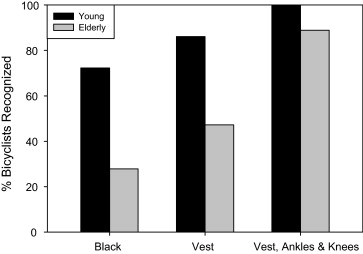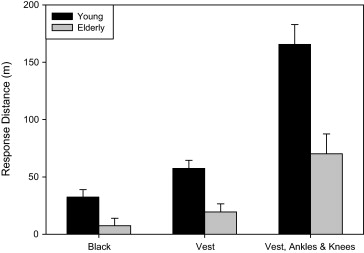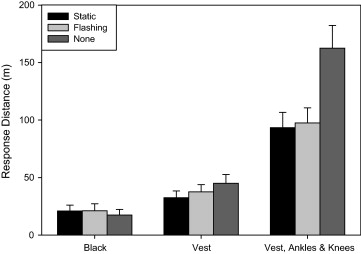Research carried out by Queensland University of Technology shows that reflective clothing including ankle and knee markers greatly increases the distance from which drivers can see cyclists. Surprisingly, the use of lights can actually reduce this distance, possibly because the lights glare the drivers.
Riding a bike at night is dangerous. Cyclists are often hit by a vehicle because the driver didn’t see them. This study set out to determine what effect the use of different types of reflective clothing would have on the visibility of cyclists to drivers. This was achieved using an experiment in which drivers traveled along a road towards a cyclist and indicated when they first saw them. The cyclists wore black clothing. The effectiveness of adding a reflective vest, and a reflective vest with the addition of ankle and knee reflectors was then tested. Variations of lighting were also included in the experiment. These included no light, a static light, and a flashing light.
24 drivers took part in the study. These were made up of a young and an old group. The young group was 6 men and 6 women between the ages of 18 and 35 years. The old group was 8 men and 4 women between the ages of 66 and 80 years.
The most effective high visibility clothing was a vest with the addition of ankle and knee reflectors. This greatly increased the distance at which cyclists were seen. The use of a light, however, did not improve the cyclists’ visibility to drivers. At one extreme, when only black clothing was worn and no lights were used, the older drivers didn’t see the cyclists at all in 73 percent of laps and the mean distance at which they were seen as only 5 meters. At the other extreme, when a vest, ankle and knee reflectors were worn, younger drivers never failed to see the cyclists, regardless of whether or not they used lights. They actually saw them from the greatest distance without lights, a mean distance of 223 meters.

Surprisingly, by far the greatest improvement in visibility was seen by adding the ankle and knee reflectors. Averaged over the driver age groups and lighting conditions, the cyclists dressed only in black were seen at 20 meters. With a vest this increased to 38 meters, but when ankle and knee reflectors were added the distance was 118 meters. It is thought that placing markers on the extremities makes people more visible due to our visual sensitivity to patterns of human motion, refered to as biomotion. This effect has been documented extensively for pedestrians..

Perhaps even more surprisingly, the use of lights did little to improve the cyclists’ visibility. When the angle and knee reflectors were worn the lights actually reduced visibility, possibly because the lights glare the drivers. These counterintuitive results may mean that cyclists believe they can be seen when they can not. This could lead to dangerous situations.

Abstract:
Bicycling at night is more dangerous than in the daytime and poor conspicuity is likely to be a contributing factor. The use of reflective markings on a pedestrian’s major joints to facilitate the perception of biological motion has been shown to greatly enhance pedestrian conspicuity at night, but few corresponding data exist for bicyclists. Twelve younger and twelve older participants drove around a closed-road circuit at night and indicated when they first recognized a bicyclist who wore black clothing either alone, or together with a reflective bicycling vest, or a vest plus ankle and knee reflectors. The bicyclist pedalled in place on a bicycle that had either a static or flashing light, or no light on the handlebars. Bicyclist clothing significantly affected conspicuity; drivers responded to bicyclists wearing the vest plus ankle and knee reflectors at significantly longer distances than when the bicyclist wore the vest alone or black clothing without a vest. Older drivers responded to bicyclists less often and at shorter distances than younger drivers. The presence of a bicycle light, whether static or flashing, did not enhance the conspicuity of the bicyclist; this may result in bicyclists who use a bicycle light being overconfident of their own conspicuity at night. The implications of our findings are that ankle and knee markings are a simple and very effective approach for enhancing bicyclist conspicuity at night.
Reference:
“Using reflective clothing to enhance the conspicuity of bicyclists at night“
Joanne M Wood, Richard A Tyrrell, Ralph Marszalek, Philippe Lacherez, Trent Carberry, Byoung Sun Chu
Accident analysis and prevention, 2012, Vol.45, p.726-730
Let us know what you think